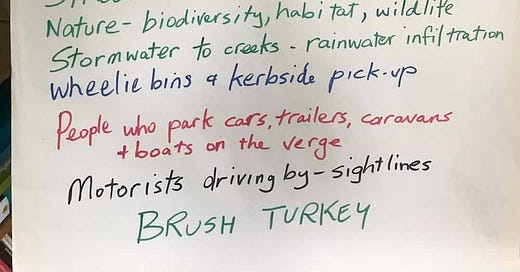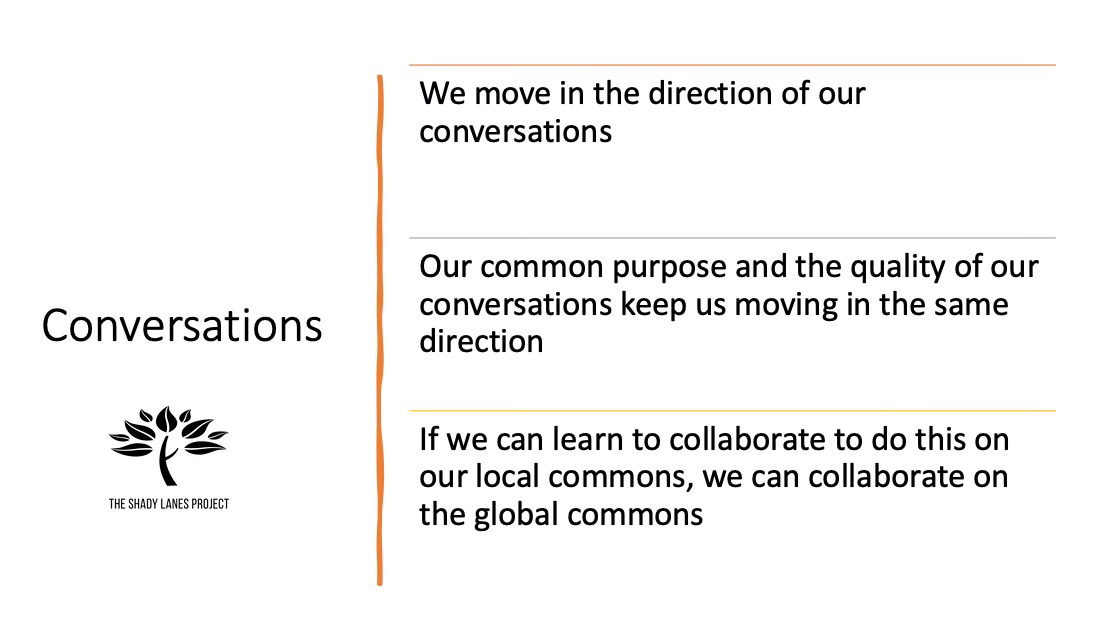Verge Garden Policies and Why they Matter
You can approach a verge garden policy as a simple set of rules but that's not always helpful.
On Sunday, members from the
and the Keep Sandgate Beautiful Association met to discuss the BCC verge garden policy and why it matters.An obvious way to discuss a policy is to go through each point step by step. Do this, don’t do that. But people can read these documents themselves and repeating them is not really helpful.
Plants grow, gardens evolve, and memories of the rules fade. A garden that breaks no obvious rules today may be very different next year.
Verges vary so much that a comprehensive policy would be too long and complicated. So, we have general rules and, just as we stop at every red light because we want everyone else to do the same, we follow the rules even if they don’t seem applicable to our particular verge.
To understand the policy and rules, we focused on the context in which councils create verge garden policies to regulate public planting by residents.
Viewpoints: Apron or Corridor
We started with the different views about verges. Many residents think of the verge as an apron to their home, with their garden extending beyond the front fence. But if you stand on the verge and turn to look down the street, it becomes part of a corridor. That corridor for people, nature, and services is our suburban long paddock.
Councils will view it as part of a corridor, and so will people walking past to get to the bus, or shop, or school. When there is a dispute, it is often because of these two different ways of looking at the same garden.
An Apron or a Long Paddock
Perspectives change when you look at things from different angles. Are verges aprons to our houses or corridors in a street? Or viewed from above, are they like networks or veins of our cities? Car-centric culture where people come and go by private car encourages the view of the verge as an apron in front of a house. When you arrive home, it’s like a we…
Users and Uses of the Verge
Then we talked about the many Users and Uses of the verge using the examples from an earlier workshop.
Your verge garden will affect every one of these. Every person will have an opinion. Some might love it; others might hate it.
If you want your verge garden to encourage others to value biodiversity and nature and help cool and green our cities, you want as many of these people as possible to react positively to your verge garden.
And you want to make sure that your effect on nature and biodiversity, both on your verge and in surrounding area, is as positive as you can make it.
The only exception is the one in red - people who park their car, boat etc. on the verge. As well as being inconsiderate to the other users of the space, it is illegal to park on the verge almost everywhere in Australia. Even so, it can be wise to proceed slowly and carefully, and compromise if necessary.
Often residents will say that nobody walks there, people walk on the road, so why should they have to leave a path?
Just because you haven’t seen anyone walking on your street, doesn’t mean it never happens, or won’t happen at any time in the future. Remember that pedestrians include people of all ages and abilities, day and night, and not just people who currently live in your street. Your garden cannot force them to walk on the road.
The council officers who create these policies are used to thinking about all these uses and users so their knowledge and experience is reflected in the restrictions and recommendations. What some residents see as petty bureaucracy is an attempt to help residents avoid making mistakes, getting into disputes, and reduce risk to everyone concerned.
Our Three Guiding Principles aim to satisfy as many of these users and uses as possible so we get the greatest impact - more people onside and involved, and more natural biodiversity and native habitat.
Comply with your local council policy
Respect the needs and views of all potential users and uses of the space
Plant predominantly local native plants
While these principles are important for individual residents, they are vital to the success of group projects and collaborations. Without them, verge gardens will never become mainstream and we’ll miss all the benefits and opportunities they offer.
Every verge garden is a simple collaboration between the council, the resident, and nature, with the aim that all three work in the same direction with a shared purpose of making our cities more sustainable quickly and at scale.
If you are running a group project, any rogue gardeners who insist on flouting these principles and gets into a dispute will undermine the success of your whole project.
That means group leaders have to manage their projects so that members stay on track. In a community group, especially informal groups where nobody can tell anyone else what to do, that isn’t easy.
We manage our groups with conversations
The way we talk to, and about, each other is the key. I often hear comments like these.
Stupid council has these petty rules about what I can plant on my own verge
This backward council ought to have a verge garden policy like others do
You can’t let people plant because they’ll plant silly things and get into fights with their neighbours
Where do these conversations take us? Do they build the relationships and trust needed to work together for our shared purpose? Or is it like the climate wars where we just keep shouting at each other and nothing changes?
What happens if we turn these statements into questions and ask things like?
What might the Council have considered in making this decision? What are they trying to make happen? What risks are they trying to minimise?
What is it that makes a Council reluctant to have a policy and allow planting? How can we help councils and other opponents feel confident that residents would choose appropriate plants and maintain the garden long-term?
How does this garden make me feel? How should my garden feel to other people if I want their support?
The Understanding the Space section is for individual gardeners and for groups to use as conversation starters. It’s worth revisiting as your perspective changes.
Managing the conversations and the relationships needed to bring together a diverse group of people and keep them moving in the right direction is one of the many topics we explore in more depth in the paid community section of this website. Please consider joining us.
If we can learn to collaborate on our local commons,
we can build the skills and experience to collaborate on the global commons.
Note to Community Members
It can take several conversations to bring your group members around to this attitude. Casual verge visits and encouraging them to think about their own reactions to different types of verge gardens can help.
Nonetheless, you will have some potential members who refuse to budge. It is better to cut them loose to do their own thing so that their actions don’t detract from your group and relationships with councils and other member of the community.
The post above is public so any comments you make here will also be public.
Please go here to discuss in the closed community with other group leaders.






